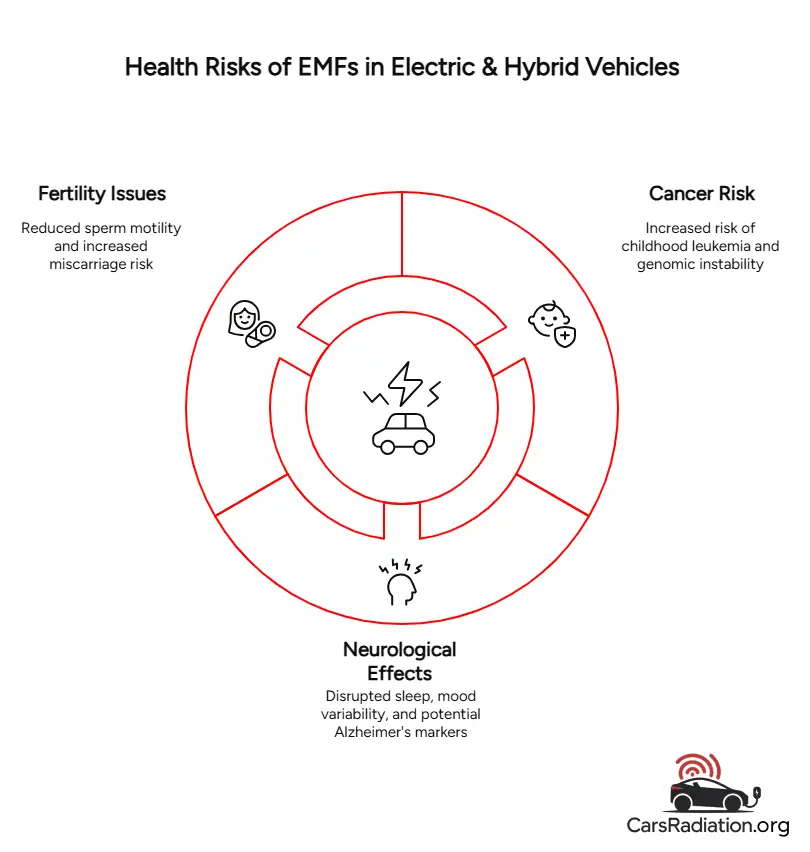Health Impacts of EMFs in Electric & Hybrid Cars

The electrification of transportation, driven by the move toward reduced emissions and higher energy efficiency, has led to the widespread adoption of electric and hybrid vehicles (EVs and HEVs). These platforms, while eliminating exhaust fumes from the engine, introduce a new physical phenomenon into the vehicle environment: electromagnetic field (EMF) radiation.
Unlike traditional internal combustion engine vehicles, electric and hybrid systems rely on high-voltage batteries, inverters, and complex power electronics, all of which generate various forms of EMF. This page outlines the known and potential biological interactions with EMF, focusing on exposure scenarios relevant to passengers and drivers.
Primary impact domains examined include:
- Oncological risk
- Neurological effects
- Reproductive system implications
In addition, mitigation mechanisms and regulatory benchmarks are briefly reviewed to understand the current safety setting.
Overview of Radiation in Vehicles
Radiation present in electric and hybrid vehicles can be categorized as non-ionizing electromagnetic radiation. This includes:
- Static magnetic fields – primarily due to permanent magnets and direct currents from traction batteries.
- Extremely low-frequency (ELF) magnetic fields – typically associated with AC inverter outputs and onboard power conversion electronics.
- Radiofrequency (RF) emissions – originating from wireless connectivity modules, infotainment systems, and diagnostic telematics.
It is important to distinguish between ionizing and non-ionizing fields. While non-ionizing fields do not carry sufficient energy to break DNA bonds directly, ELF fields in particular are known to induce low-level currents within biological tissues. These currents interact with electrochemical processes, such as ion transport.1
Comparative measurements show that magnetic field strengths inside EVs and HEVs can exceed those observed in conventional vehicles, particularly in proximity to powertrains, high-current cabling, or underfloor battery configurations.
Field strengths of over 20 µT have been reported in select cabin locations, significantly above ambient residential exposure levels, which are typically <0.1 µT.
Mechanisms of Radiation Effect on Health
Electromagnetic field exposure affects biological systems via two principal mechanisms:
- Thermal effects – relevant mainly to RF fields; involve tissue heating at high intensities, generally well characterized and controlled.
- Non-thermal effects – associated with ELF fields; may alter biological processes without a detectable temperature rise.
Mechanistic studies suggest EMFs may influence:
- Voltage-gated ion channels (notably calcium influx)
- Neuroendocrine signaling
- Reactive oxygen species (ROS) generation and oxidative DNA damage
- Melatonin suppression and circadian rhythm disruption
These processes can lead to cumulative physiological stress, particularly under chronic low-level exposure. Vehicle EMF exposure is characterized by close proximity, enclosed space, and repetitive duration; conditions that may exacerbate cumulative risk over time.
Acute symptoms, while generally transient, can include dizziness or fatigue; chronic exposure is associated with more persistent changes in neurological and cellular function.2
Health Effect Areas
Cancer
 The International Agency for Research on Cancer (IARC), under WHO auspices, has classified ELF magnetic fields as possibly carcinogenic to humans (Group 2B), primarily based on epidemiological evidence of increased childhood leukemia risk.
The International Agency for Research on Cancer (IARC), under WHO auspices, has classified ELF magnetic fields as possibly carcinogenic to humans (Group 2B), primarily based on epidemiological evidence of increased childhood leukemia risk.
EMFs in electric vehicles, due to their frequency and amplitude, are functionally analogous to those associated with electrical power infrastructure, a known reference point in public health risk frameworks.
While longitudinal studies specific to vehicle EMFs remain limited, animal studies subjected to comparable field strengths show increased markers of genomic instability, such as increased 8-OHdG (a biomarker of oxidative DNA damage) and dysregulation in gene expression profiles associated with apoptosis and cell proliferation.
Given that field magnitudes inside vehicles can meet or exceed thresholds used in such experimental models, a precautionary principle is warranted.
Neurological Effects
EMF interaction with the central and peripheral nervous systems has been studied extensively in both clinical and experimental settings. Potential pathways of concern include:
- Disruption of calcium signaling cascades
- Altered neurotransmitter release dynamics
- Changes in blood-brain barrier permeability
Symptoms linked to chronic EMF exposure include:
- Reduced memory recall and cognitive clarity
- Disrupted sleep architecture (notably REM phase shortening)
- Mood variability, including irritability and depressive episodes
- Increased headache incidence
Melatonin suppression, due to pineal gland sensitivity to ELF fields, represents a plausible pathway for sleep-related and neurodegenerative outcomes. Some studies suggest statistical correlation between long-term EMF exposure and Alzheimer’s disease markers, although causality remains to be formally established.
Fertility
 Reproductive system vulnerability to EMFs (particularly in developing organisms and during gestation) has been documented in multiple research models. Observed Effects include:
Reproductive system vulnerability to EMFs (particularly in developing organisms and during gestation) has been documented in multiple research models. Observed Effects include:
- Reduced sperm motility and increased morphological defects in males3
- Hormonal imbalance affecting the hypothalamic-pituitary-gonadal axis
- Increased incidence of miscarriage and intrauterine growth retardation (IUGR)
Vehicle exposure is characterized by anatomical proximity to emission sources. In many EV designs, occupants are seated directly above battery modules or power control units, increasing localized field intensity. Such exposure profiles merit concern, especially for pregnant individuals and adolescents, due to increased biological sensitivity.

Mitigation and Risk Reduction Strategies
To address EMF exposure within vehicles, both passive and active engineering controls are implemented. These include:
- Component Shielding – deployment of ferromagnetic or conductive materials around high-current components and cables to attenuate field propagation.
- Optimized Cable Topology – routing conductors to minimize loop area and magnetic flux density in passenger zones.
- Active Cancellation Technologies – systems such as those developed by SafeFields™ introduce controlled anti-phase magnetic fields to neutralize net emissions.
Consumer-level mitigation recommendations include:
- Avoiding prolonged stationary periods inside a charging vehicle
- Reducing time spent in seating positions directly above powertrain assemblies
- Prioritizing models with independently verified low-EMF cabin environments
Despite these measures, it must be recognized that the intrinsic operation of electric and hybrid vehicles involves field generation. Therefore, any detailed safety standard must consider chronic exposure thresholds and support harmonized test methodologies, such as those defined in IEC 62764 and IEC 62226, to assess compliance.
References
- International Commission on Non-Ionizing Radiation Protection (ICNIRP) — Environmental Health Criteria 238
- National Library of Medicine — Complex Electromagnetic Issues Associated with the Use of Electric Vehicles in Urban Transportation
- Bioinitiative — Bioinitiative Report 2012

